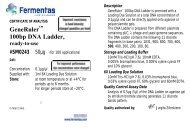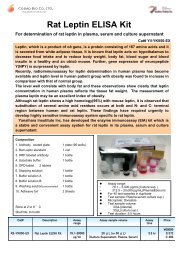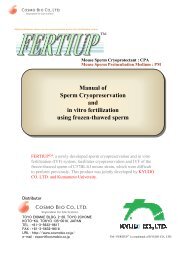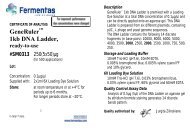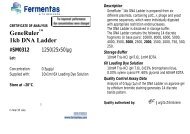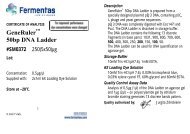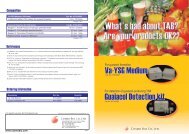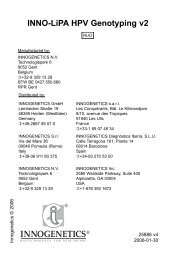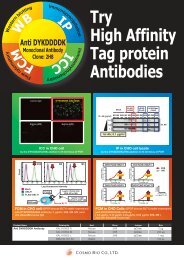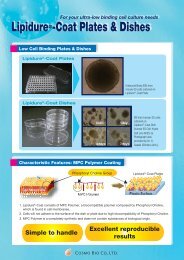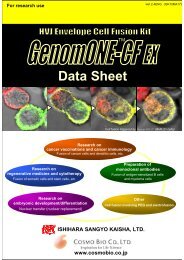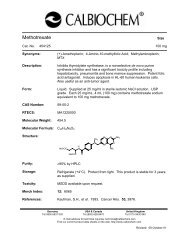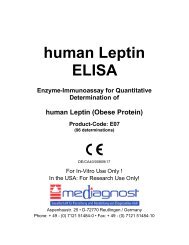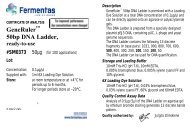TOYO 2CHOME, KOTO-KU, TOKYO, 135-0016, JAPAN http://www ...
TOYO 2CHOME, KOTO-KU, TOKYO, 135-0016, JAPAN http://www ...
TOYO 2CHOME, KOTO-KU, TOKYO, 135-0016, JAPAN http://www ...
- No tags were found...
Create successful ePaper yourself
Turn your PDF publications into a flip-book with our unique Google optimized e-Paper software.
YII-YK240-EX Corticosterone EIAProduct InstructionsFOR LABORATORY USE ONLY<strong>TOYO</strong> <strong>2CHOME</strong>, <strong>KOTO</strong>-<strong>KU</strong>, <strong>TOKYO</strong>, <strong>135</strong>-<strong>0016</strong>, <strong>JAPAN</strong><strong>http</strong>://<strong>www</strong>.cosmobio.co.jp e-mail : export@cosmobio.co.jpPhone : +81-3-5632-9617 FAX : +81-3-5632-9618
Contents. Introduction 2. Characteristics 3. Composition 3. Method 4-5. Notes 5-6. Performance Characteristics 6-11. Stability and Storage 12. References 12. Appendix 13– Please read all the package insert carefully before beginning the assay –1
YII-YK240-EX Corticosterone EIA KitI. IntroductionCorticosterone (C 21 H 30 O 4 , also called 11,21-Dihydroxyprogesterone, Reichstein’s Substance H,or Kendall’s Compound B) is, like cortisol and cortisone, a glucocorticoid hormone secreted from thecortex of adrenal gland. Corticosterone is derived from cholesterol through a series of enzymaticallymediated steps and also serving as a precursor of aldosterone. It is a primary glucocorticoid in miceand rats and other animals (such as rabbits, birds, amphibians, and reptilians) in which the17-hydroxylase is supposed not to exist in adrenal gland. Corticosterone is produced under thecontrol of ACTH and the production has a circadian rhythm with peak levels in the latter portion ofthe day in nocturnal animals like rats and is believed to play a decisive role in sleep-wake cycles (1) .Corticosterone can be used as a non-invasive biomarker of stress study through the collection ofurine and feces to avoid corticosterone increase of blood levels which is caused by normal invasivemethods (2) . Corticosterone is also being studied in different fields such as impairment of long-termmemory retrieval (3) , chronic corticosterone elevation due to dietary restrictions (4) and response toburn injuries (5) etc.Since most of corticosterone in blood is bound to a plasma protein called corticosteronebindingglobulin (CBG), the determination of blood corticosterone with presently availablecommercial assay kits requires an initial extraction procedure. On the other hand, the presentassay kit for corticosterone newly developed by our laboratory provides a tool for directdetermination of corticosterone in blood by simple dilution of blood samples with the diluentincluded in the kit. Furthermore, assays using the kit can be completed within a short period. Thecorticosterone EIA kit newly developed will be a quite useful tool for further development ofcorticosterone research.YII-YK240-EX Corticosterone EIA Kit Contents The assay kit range: 0.21-50ng/mL. The assay running time: 2h. + 0.5 h. Maximum measurable samples: 41 in duplicate Test sample: plasma, serum, urine, and cell or tissue culturesupernatant etc. The 96-well plate in the kit is consisted of 8-wells strips, so thatthe kit can be used dividedly in strips. Intra-assay %CV: 2.5~4.7 Inter-assay %CV: 7.5~9.8. Store all the components in the kit at 2-8˚C. The kit is stableunder the condition for 6 months from the date of themanufacturing.The expiry date is stated on the package.1) Antibody Coated Plate2) Corticosterone Standard3) HRP-Labeled Corticosterone4) Specific Antibody5) TMB Substrate6) Reaction Stopping Solution7) Buffer Solution8) Sample Diluent9) Wash Solution Concentrated10) Adhesive Foil2
II. CharacteristicsThis EIA kit is used for quantitative determination of corticosterone in biological fluids such asplasma, serum or urine samples of mice, rats and other species, and also cell or tissue culturesupernatant. It has various advantages, such as no extraction procedure of samples, short assaytime, practically no influences of other body fluids or physiological active substances coexisting insamples assayed.< Specificity >The specificity of this EIA kit is shown on page 10.< Assay Principle > This EIA kit for determination of corticosterone is based on a competitive enzyme immunoassayusing combination of specific antibody to corticosterone and corticosterone- horseradishperoxidase (HRP) conjugate (HRP-labeled corticosterone) system. The 96 wells plate is coated withgoat anti rabbit IgG, to which corticosterone standard or samples, HRP-labeled corticosterone andspecific antibody are added for competitive immunoreaction. After incubation and plate washing,HRP enzyme activity is determined by 3,3’,5,5’- tetramethylbenzidine (TMB) and the concentrationof corticosterone is calculated.III. Composition Component Form Quantity Main Ingredient1 Antibody Coated Plate microtiter plate 1 plate (96 wells) Goat anti rabbit IgG2 Corticosterone Standard lyophilized powder 1 vial (50ng) Synthetic corticosterone3 HRP-Labeled Corticosterone lyophilized powder 1 vial HRP conjugated corticosterone4 Specific Antibody liquid 1 bottle (7 mL) Rabbit anti corticosterone antibody5 TMB Substrate liquid 1 bottle (12 mL) 3,3’,5,5’-Tetramethylbenzidine (TMB)6 Reaction Stopping Solution liquid 1 bottle (12 mL) 1M Sulfuric acid7 Buffer Solution liquid 1 bottle (10 mL) BSA-containing PBS buffer8 Sample Diluent liquid 1 bottle (50 mL) A specially formulated displacer of CBG9 Wash Solution Concentrated liquid 1 bottle (25 mL) Concentrated saline10 Adhesive Foil 2 sheets 3
IV. Method< Equipment required >1. Photometer for microtiter plate (plate reader), which can read extinction 2.5 at 450 nm2. Washing device for microtiter plate and dispenser with aspiration system (optional)3. Micropipettes for volumes between 10 L –1000 L4. Multi-channel pipettes for 8 or 12 wells and the tips5. Glass test tubes for preparation of standard and sample solutions6. A microplate shaker (210-240 rpm)7. Graduated cylinder (500 mL or 1,000 mL)8. Distilled or deionized water< Preparatory work >1. Preparation of corticosterone standard solution: Reconstitute lyophilized CorticosteroneStandard (50 ng/vial) with 1mL of Sample Diluent, which affords 50 ng/mL standard solution.The reconstituted corticosterone standard solution (0.2 mL) is diluted with 0.4 mL of SampleDiluent that yields 16.67 ng/mL standard solution. Repeat the same dilution to make standardsolution of 5.56, 1.85, 0.62, and 0.21 ng/mL, respectively. Sample Diluent is used as 0ng/mL.2. Preparation of HRP-labeled corticosterone solution: Reconstitute HRP-Labeled Corticosteronewith 7mL of Buffer Solution.3. Dilution of Wash Solution Concentrated: Dilute one bottle of Wash Solution Concentrated (25mL) to 500 mL with distilled or deionized water.4. Other reagents are ready for use.1. For mouse/rat plasma and serum: Dilute 10 L of plasma or serum sample with 400 L ofSample Diluent in a test tube. Mix the diluted solution and allow it to stand still for 10 minutesat room temperature.2. For mouse/rat urine: Dilute 10 L of urine sample (40-100 folds) with Sample Diluent in a testtube. Mix the diluted solution and allow it to stand still for 10 minutes at room temperature.3. For culture supernatant (RPMI1640 with or without FCS): Dilute 50 L of supernatant with250 L of Sample Diluent in a test tube. Mix the diluted solution and allow it to stand still for10 minutes at room temperature.4. For other species or matrix samples: Because corticosterone concentrations are differentsignificantly in various species of animals, it is recommended that a series of diluted samplesare prepared and tested to find the optimal dilution ratio before assay.4
Assay procedure >1. Before starting assay, bring all the reagents, except test samples, to room temperature(20-30°C).2. Add 350 µL of diluted wash solution to each well and keep it for about 30 seconds, and thenaspirate or decant the wash solution in the wells. Invert the plate and tap it onto an absorbentsurface, such as paper toweling, to ensure blotting free of most residual wash solution.3. Pipet 100 µL of corticosterone standard solutions (0, 0.21, 0.62, 1.85, 5.56, 16.67, and 50ng/mL) or diluted samples, after vortexed, into appropriate wells. Add 50µL of HRP-labeledcorticosterone solution into each well, and finally add 50 µL of Specific Antibody into eachwell.4. Cover the plate with adhesive foil and incubate it on a shaker at 210-220 rpm at roomtemperature for 2 hours.5. After incubation, take off the adhesive foil, aspirate or decant the solutions in the wells. Add350 µL of diluted wash solution to each well and keep it for about 30 seconds, and thenaspirate or decant the wash solution in the wells. Repeat this wash process 4 times (total 5times). Finally, invert the plate and tap it onto an absorbent surface, such as paper toweling,to ensure blotting free of most residual wash solution.6. Add 100 µL of TMB Substrate into each well.7. Cover the plate with adhesive foil and incubate it on a shaker at 210-220 rpm at roomtemperature for 30 minutes.8. Add 100 µL of Reaction Stopping Solution into each well to stop color reaction.9. Read the optical absorbance of the wells at 450 nm.10. The assay fits best to a 4-parameter logistic equation, Y= (a-d)/(1+(x/c)^b)+d; here a,b,c,drepresent constant parameter. The result of unknown samples can be calculated with anycomputer program having a 4-parameter logistic function. Alternatively, calculate meanoptical density values of wells containing standard solutions or their percent bound tomaximum binding wells (0 ng/mL) and plot a standard curve on a semi-logarithmic graphpaper (abscissa: concentrations of standard; ordinate: optical density values or bound%).Use the average optical density or bound% of each sample to determine the correspondingvalue by simple interpolation from the standard curve.V. Notes1. It is recommended that serum or plasma samples should be used as soon as possible aftercollection. If the sample is tested later, they should be aliquoted and frozen below –30°C (forlong term storage, in a –80°C deep freezer). Avoid repeated freezing and thawing of samples.2. Corticosterone standard solutions and HRP-labeled corticosterone solution should beprepared immediately before use. If the kit used dividedly, the rests of the reconstitutedcorticosterone standard solution (50 ng/mL), HRP-labeled corticosterone solution and otherreagents except wash solution should be stored at 4°C and used within 2 weeks. Dilutedstandard solutions, except 50 ng/mL of standard solution, should not be reused for anotherassay.5
3. The recommended diluting ratio for mouse or rat sample is 20-100 folds, but corticosteronelevels significantly differ among animals and also show marked circadian variation even in thesame individual. Therefore, optimal dilution test should be run when handling test samples ofspecies other than mice and rats. In addition, since progesterone level increases significantlyin pregnant animal, the cross reactivity of the steroid should be considered (refer to page 10) when such samples are tested.4. Incomplete washing of the microplate will interfere with assay precision. If a microplatewasher is not available, completely aspirate the solutions in the wells of assay plate to beremoved or decant them by inverting the plate and tapping it onto absorbent tissue in eachwash cycle. Ensure that there is no residual wash solution in the wells after final wash.5. As pipetting operations may affect precision of the assay, pipet corticosterone standardsolutions or samples precisely into the wells of assay plate. In addition, use clean test tubesor vessels in assay and a new tip for each standard diluting process and for each sample orstandard solution pipetting to avoid cross contamination.6. Perform all the determination in duplicate.7. To quantitate accurately, always run a standard curve for each assay.8. Color reaction should be carried out under the light proof condition.9. Read optical absorbance of reaction solution in wells as soon as possible after stopping thecolor reaction.10. Protect the reagents from strong light (e.g. direct sunlight) during storage and assay.11. Satisfactory performance of the assay will be guaranteed only when reagents are used fromcombination pack with identical lot number.VI. Performance Characteristics < Assay range > 0.21 – 50 ng/mL6
Sensitivity can be calculated using the following formula under the guidelines listed in theNational Committee for Clinical Laboratory Standards (NCCLS) Evaluation Protocols (6) .2SD of the Zero Standard0.21 ng/mLSensitivity (ng/mL)(Optical Density of 0ng/mLOptical Density of 0.21ng/mL)< Precision and reproducibility >Intra-assay variation (mean±SD, n=10) Inter-assay variation (mean±SD, n=9) Measured (ng/mL) %CV Measured (ng/mL) %CVQC sample 1 0.767±0.036 4.7 0.767±0.063 8.2QC sample 2 2.802±0.105 3.7 2.655±0.205 7.7QC sample 3 7.837±0.197 2.5 6.951±0.683 9.8< Analytical recovery >Mouse serum Corticosterone Observed Expected Recoveryadded (ng/mL) (ng/mL) (ng/mL) (%)No. 1 0 5.9331.52 7.728 7.453 103.74.55 10.202 10.483 97.313.64 18.696 19.573 95.5No. 2 0 4.6601.52 5.854 6.180 94.74.55 8.464 9.210 91.913.64 15.779 18.300 86.2No.3 0 2.6291.52 3.943 4.149 95.04.55 6.530 7.179 91.013.64 14.148 16.269 87.0Mouse plasma Corticosterone Observed Expected Recoveryadded (ng/mL) (ng/mL) (ng/mL) (%)No.1 1.52 4.257 4.358 97.74.55 6.577 7.388 89.013.64 14.120 16.478 85.7No.2 0 2.8431.52 4.215 4.363 96.64.55 6.569 7.393 88.97
13.64 14.267 16.483 86.6No.3 0 2.8551.52 4.197 4.375 95.94.55 6.915 7.405 93.413.64 14.801 16.495 89.7Rat serum Corticosterone Observed Expected Recoveryadded (ng/mL) (ng/mL) (ng/mL) (%)No.1 0 4.9081.52 6.711 6.428 104.44.55 9.888 9.458 104.513.64 20.396 18.548 110.0No.2 0 5.4621.52 6.317 6.982 90.54.55 10.117 10.012 101.013.64 19.222 19.102 100.6No.3 0 4.0431.52 5.194 5.563 93.44.55 8.209 8.593 95.513.64 16.777 17.683 94.9Rat plasma Corticosterone Observed Expected Recoveryadded (ng/mL) (ng/mL) (ng/mL) (%)No.1 0 6.7551.52 7.777 8.275 94.04.55 11.546 11.305 102.113.64 22.639 20.395 111.0No.2 0 6.5671.52 7.645 8.087 94.54.55 10.816 11.117 97.313.64 22.094 20.207 109.3No.3 0 4.4631.52 5.589 5.983 93.44.55 8.824 9.013 97.913.64 18.032 18.103 99.6Mouse urine Corticosterone Observed Expected Recoveryadded (ng/mL) (ng/mL) (ng/mL) (%)No.1 0 6.3321.52 8.340 7.852 106.24.55 12.603 10.882 115.813.64 22.998 19.972 115.28
No.2 0 2.5781.52 4.476 4.098 109.24.55 7.957 7.128 111.613.64 18.517 16.218 114.2Tissue culture medium Corticosterone Observed Expected Recoveryadded (ng/mL) (ng/mL) (ng/mL) (%)RPMI-1640 0 2.3791.52 3.711 3.899 95.24.55 6.821 6.929 98.413.64 16.496 16.019 103.0RPMI-1640+ 0 0.72310% FCS 1.52 2.031 2.243 90.54.55 5.105 5.273 96.813.64 14.881 14.363 103.6Mouse serum Dilution ratio Observed Expected % of expected(1X ) (ng/mL) (ng/mL)No.1 1 6.5502 3.368 3.275 102.84 1.700 1.638 103.88 0.936 0.819 114.3No.2 1 5.4082 2.707 2.704 100.14 1.450 1.352 107.28 0.808 0.676 119.5No.3 1 3.7922 1.968 1.896 103.84 1.022 0.948 107.88 0.526 0.474 111.0Mouse plasma Dilution ratio Observed Expected % of expected(1X ) (ng/mL) (ng/mL)No.1 1 3.0332 1.532 1.517 101.04 0.808 0.758 106.68 0.430 0.379 113.4No.2 1 2.8942 1.559 1.447 107.74 0.838 0.724 115.89
8 0.436 0.362 120.5No.3 1 2.4862 1.121 1.243 90.24 0.564 0.622 90.78 0.308 0.311 99.1Rat serum Dilution ratio Observed Expected % of expected(1X ) (ng/mL) (ng/mL)No.1 1 7.6602 3.414 3.830 89.14 1.690 1.915 88.38 0.895 0.958 93.5No.2 1 6.6922 3.201 3.346 95.74 1.618 1.673 96.78 0.765 0.837 91.5No.3 1 4.7972 2.302 2.399 96.04 0.981 1.199 81.88 0.583 0.600 97.2Rat plasma Dilution ratio Observed Expected % of expected(1X ) (ng/mL) (ng/mL)No.1 1 6.6742 3.123 3.337 93.64 1.666 1.669 99.98 0.786 0.834 94.2No.2 1 8.3232 3.969 4.162 95.44 1.831 2.081 88.08 0.981 1.040 94.3No.3 1 4.6352 2.359 2.318 101.84 1.186 1.159 102.48 0.595 0.579 102.7Mouse urine Dilution ratio Observed Expected % of expected(1X ) (ng/mL) (ng/mL)No.1 1 7.8412 3.642 3.921 92.94 2.011 1.960 102.68 1.095 0.980 111.710
No.2 1 2.9122 1.479 1.456 101.64 0.874 0.728 120.18 0.536 0.364 147.3Tissue culture medium Dilution ratio Observed Expected % of expected(1X ) (ng/mL) (ng/mL)RPMI-1640 1 2.7102 1.330 1.355 98.24 0.652 0.678 96.28 0.320 0.339 94.5RPMI1640+ 1 0.86610% FCS 2 0.586 0.433 <strong>135</strong>.34 0.240 0.217 110.98 0.108Cross reactivities of the antibody used in the kit.Compound Cross Reactivity (%)Corticosterone 10011-Deoxycorticosterone
VII. Stability and Storage< Storage > Store all the components in the kit at 2 to 8°C.< Shelf Life > The Kit is stable under the condition for 6 months from the date ofmanufacturing.The expiry date is stated on the label of package.< Package > For 96 tests per one kit including standards.VIII. References1. Vázquez-Palacios G, Retana-Márquez S et al: Further definition of the effect ofcorticosterone on the sleep-wake pattern in the male rat. Pharmacol Biochem Behav70:305-310, 20012. Goymann W, Möstl E and Gwinner E: Corticosterone metabolites can be measurednoninvasively in excreta of European Stonechats (Saxicola torquata rubicola). TheAuk 119:1167-1173. 20023. Hupe JM, James AC et al: Cortical feedback improves discrimination between figureand background by V1, V2 and V3 neurons. Nature 394:784-787, 19984. Kitaysky AS, Kitaiskaiya EV et al: Dietary restriction causes chronic elevation ofcorticosterone and enhances stress response in red-legged kittiwake chicks. JComp Physiol B: Regulatory, Integrative and Comparative Physiology 171:701-709, 20015. Thelling O, Noel G et al: Stress hormone secretion and gut signal transducer (STAT)proteins after burn injury in rats. Shock 16:393-397, 2<strong>0016</strong>. National Committee for Clinical Laboratory Standards Evaluation Protocols, SC1 (1989),Vallanova, PA: NCCLSManufactured by Yanaihara Institute Inc.<strong>TOYO</strong> <strong>2CHOME</strong>, <strong>KOTO</strong>-<strong>KU</strong>, <strong>TOKYO</strong>, <strong>135</strong>-<strong>0016</strong>, <strong>JAPAN</strong><strong>http</strong>://<strong>www</strong>.cosmobio.co.jp e-mail : export@cosmobio.co.jpPhone : +81-3-5632-9617 FAX : +81-3-5632-9618Update at: Nov. 26, 200912
IX. AppendixThe YK240 Corticosterone EIA kit has been compared to other commercially availableCorticosterone EIA kit. Thirty-seven samples of mouse and rat plasma or serum were assayedand linear regression analysis of the results yielded as shown in the graph. 13



